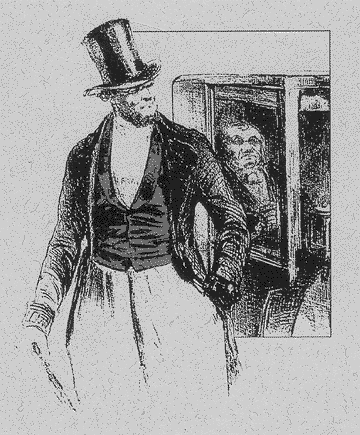



Created & Written by: Emile Gaboriau (1832-1873)
1. LITERARY CONTEXT
Emile Gaboriau has often been dubbed the
founding father of the modern detective novel.
 There were other precursors in the genre: Edgar Allan Poe's Chevalier Dupin
made his first appearance in The Murders in the Rue Morgue in 1841.
There were other precursors in the genre: Edgar Allan Poe's Chevalier Dupin
made his first appearance in The Murders in the Rue Morgue in 1841.
Honoré de Balzac's Comedie Humaine novels introduced the notorious Vautrin in Le Père
Goriot in 1834 -- Vautrin was a character inspired by the real-life Vidocq, a former convict who rose to become head of the
French Surete, before opening the world's first detective agency. Vidocq's Memoirs were an influence on Poe's Dupin.
Paul Féval's Les
Mystères de Londres (1844) and Les Habits Noirs (The
Black Coats) (1863-75), a huge saga comprised of eight separate novels, introduced
the concept of organized crime, describing an evil international criminal empire, led by the mysterious immortal
figure of Colonel Bozzo-Corona.
Alexandre Dumas created the character
of Monsieur Jackal, the mysterious head
of the Paris Surete, in his novel Les Mohicans de Paris
(1854-59) -- the title of which was obviously borrowed from Fenimore Cooper.
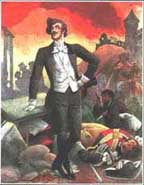 Victor-Alexis
Ponson du Terrail, the author of the saga
of Rocambole
(aka Les Drames de Paris), comprising twenty-five volumes published between 1857 and 1867, mixed all these elements
together, adding the character of a superhumanly gifted hero born to challenge the forces of evil -- one that had,
in fact, began his career on the side of evil!
Victor-Alexis
Ponson du Terrail, the author of the saga
of Rocambole
(aka Les Drames de Paris), comprising twenty-five volumes published between 1857 and 1867, mixed all these elements
together, adding the character of a superhumanly gifted hero born to challenge the forces of evil -- one that had,
in fact, began his career on the side of evil!
Even Victor Hugo's classic Les Miserables (1862) featured a remarkably persistent
detective, Inspector Javert.
But Emile Gaboriau was the first to invent
the character of the procedural detective, and place him in the context of a novel where the resolution of a murder,
not the rescue of an inheritance, a treasure, or some kind of grandiosely mad evil scheme, was at the core of the
book.

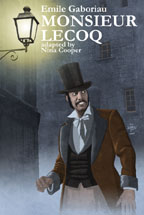
TO FIND OUT MORE, BUY THESE BOOKS
2. THE CHARACTERS
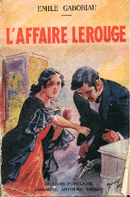 Monsieur Lecoq (no first-name was ever given by Gaboriau)
is an agent of the dreaded French Sureté. He is a methodical, scientifically minded detective who, like
Sherlock Holmes,
carefully gathers minute clues from the scene of the crime and, from them, draws logical conclusions which, at
first, amaze his colleagues but prove eminently rational when explained.
Monsieur Lecoq (no first-name was ever given by Gaboriau)
is an agent of the dreaded French Sureté. He is a methodical, scientifically minded detective who, like
Sherlock Holmes,
carefully gathers minute clues from the scene of the crime and, from them, draws logical conclusions which, at
first, amaze his colleagues but prove eminently rational when explained.
Sir Arthur Conan Doyle paid homage to
Gaboriau when he first introduced Holmes and, indeed, Monsieur Lecoq is a worthy precursor of the Great Detective,
who owes him more than a passing debt. Like Holmes, Lecoq is more than a mere crime-solver: he is a master of disguise
with a secret identity in the Paris underworld.
In the person of armchair detective Tabaret,
nicknamed Père Tireauclair, i.e,:
Father Bringer of Light, a title Lecoq himself will eventually inherit, Lecoq even has an older mentor who, like
Mycroft Holmes, helps him solve particularly challenging puzzles from the comfort of his bed.
3. THE BOOKS
Monsieur Lecoq first appeared as a supporting character, a student of the methods of Tabaret in L'Affaire Lerouge (The
Lerouge Affair), published in 1866, but taking place in 1862.
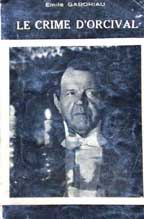 He then graduated
to the status of full-blown "hero" in Le Crime d'Orcival (The Orcival Crime),
published in 1867, but taking place in 1863.
He then graduated
to the status of full-blown "hero" in Le Crime d'Orcival (The Orcival Crime),
published in 1867, but taking place in 1863.
The newspaper serializing Lecoq's adventures saw its sales skyrocket, which encouraged Gaboriau to write the classic
Le Dossier No.113 (File
113), also in 1867, but taking place a year earlier, in 1864, and then, Les Esclaves de Paris (The
Slaves of Paris), published in 1868, taking place in 1867. Lecoq retired from
the Surete soon after.
Finally, in 1869, Gaboriau wrote Monsieur Lecoq,
which told the story of Lecoq's first case, back in 1859.
A sixth volume, La Vieillesse de Monsieur Lecoq
(Mr. Lecoq's Old Age), was written by
another popular mystery writer, Fortuné de Boisgobey, in 1878. It takes place in 1877. This novel anticipates the modern publishing phenomenon
of Sherlock Holmes pastiches. In it, Lecoq pretends to be older than he really is -- he would only be in his late
40ies -- but that is an illusion carefully cultivated because of his extra-curricular activities (see below).
Finally, La Fille de M. Lecoq (Mr. Lecoq's Daughter) was published in 1886 by & William
Busnach & Henri Chabrillat. The story takes place in the Batignolles and starts with the murder of Lecoq who
has retired and is living under the name of Muret. His dying words are "Three, the Three!". Lecoq's daughter
has to consult his hidden memoirs to solve his murder.
To this list, one should add:
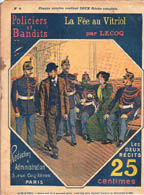 - an "offstage" appearance by Lecoq, advising another character in the Gaboriau short story
"Une Disparition" (A Disappearance), taking place sometimes in the 1870s,
- an "offstage" appearance by Lecoq, advising another character in the Gaboriau short story
"Une Disparition" (A Disappearance), taking place sometimes in the 1870s,
- a 1908 pulp magazine La Fée au Vitriol (The Vitriol Fairy) purported to be the memoirs of Lecoq's
son Lucien, who also became a policeman and is now 57,
- and a 1952 pastiche novella by J. Kéry: Le Dernier Dossier de M. Lecoq (Mr. Lecoq's Last File),
included with M. Frémond a disparu,
a Simenon pastiche, which I have not read.
4. A TENTATIVE TIMELINE OF THE LECOQ FAMILY...
1795 (Dec 13) - Albert
Lecoq is at Wold Newton (according to Philip José Farmer); he is a
member of the High Council of the Black Coats. He has a honest merchant brother in Caen, Normandy, Lambert
Lecoq. At this time the High Council includes an unnamed beautiful woman whom
I identified as Anne de Breuil, descendent
of the notorious "Milady".
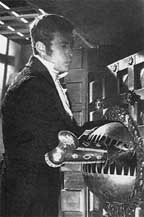 1802-03-04
- Albert Lecoq and Anne de Breuil have an affair; they have two children: Antoine
Lecoq, born in 1802, and Leo Lecoq born in 1803 or 1804. Leo (later Lecoq de la Perière aka Toulonnais L'Amitié)
could have been born in 1803 (as per The Parisian Jungle),
1790 (as per The Invisible Weapon) or
1795 (as per Salem Street). The 1908 Anonymous
Pulp Magazine says Monsieur Lecoq was born Dec 15 1804. I submit that it is actually referring to Lecoq de la Perière.
The date could be accurate or could be a misprint.
1802-03-04
- Albert Lecoq and Anne de Breuil have an affair; they have two children: Antoine
Lecoq, born in 1802, and Leo Lecoq born in 1803 or 1804. Leo (later Lecoq de la Perière aka Toulonnais L'Amitié)
could have been born in 1803 (as per The Parisian Jungle),
1790 (as per The Invisible Weapon) or
1795 (as per Salem Street). The 1908 Anonymous
Pulp Magazine says Monsieur Lecoq was born Dec 15 1804. I submit that it is actually referring to Lecoq de la Perière.
The date could be accurate or could be a misprint.
Also in 1803, seven members of the High Council of the Black Coats scheme to remove Colonel
Bozzo-Corona at the Convent of La Merci; they are executed (as per Salem Street) (this could have also taken place in 1807
as per The Invisible Weapon). Albert Lecoq
was amongst them. Subsequently, Anne dumps the two children (Antoine and Leo) on their
honest merchant uncle Lambert in Caen,
Normandy.
1821 - After relocating its operations
to France, the Colonel is briefly imprisoned in Caen, Normandy (as per The
Parisian Jungle). There, he meets Leo who by now is 18 and recruits him in the Black Coats. His older brother Antoine remains in Caen and works honestly for his uncle Lambert.
1822 - Leo is caught by the police, sent first to La Force jail (as per the 1908 Anonymous Pulp Mag),
then to the Toulon Hard Labor Camp where he picks up the nickname of Toulonnais
L'Amitié. The Anonymous Pulp Magazine claims that he was arrested because
of his Bonapartist sentiments; but this is, likely a cover-up.
1823 - Vidocq spots Leo Lecoq's
potential, releases him from Toulon and hires him for his Sûreté brigade (as per the 1908 Anonymous
Pulp Magazine); the Colonel puts him on
the High Council of the Black Coats; Leo's connection with the Sûreté is established in Salem Street.
1825 - Events of THE
PARISIAN JUNGLE 1. Leo/Lecoq de la Perière/Toulonnais
L'Amitié frames André Maynotte in Caen, Normandy; he stays in touch with his brother Antoine who has since inherited the shop upon Lambert's death (JML).
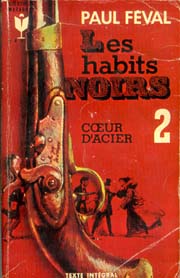 1827 - Marguerite Sadoulas, age 15, runs away from school with
her piano teacher (ás per Heart of Steel);
she meets Leo, has an affair, is recruited
in the Black Coats.
1827 - Marguerite Sadoulas, age 15, runs away from school with
her piano teacher (ás per Heart of Steel);
she meets Leo, has an affair, is recruited
in the Black Coats.
1828 - Leo and Marguerite have
a son: he is the future Monsieur Lecoq
from Gaboriau; I'll call him "Victor". Leo entrusts baby Victor to his childless brother Antoine, to
be raised in Caen. This is based on contradictory information given by Gaboriau, which makes it possible for Monsieur
Lecoq to have been born any time between 1828 and 1834. Gaboriau further states that his Lecoq is the son of a
rich and honorable family from Normandy.
1842 - Events of THE
PARISIAN JUNGLE 2. Death of Leo Lecoq
de la Perière aka Toulonnais L'Amitié at the hands of André Maynotte; Beginning of the decline of the
Black Coats.
1845 - Monsieur
(Victor) Lecoq, age 17, meets Marguerite
Loudet, the widow of one of his father Leo's Sûreté colleagues (as per the 1908 Anonymous Pulp Mag).
1846 - Monsieur
Lecoq and Marguerite Loudet have one son, Constant Lecoq
(as per the 1908 Anonymous Pulp Mag).
1848 - Monsieur
Lecoq and Marguerite Loudet have one daughter, Jeanne
(as per the 1908 Anonymous Pulp Mag). Antoine
and his unnamed wife die suddenly. Gaboriau tells is that Lecoq was embarking on the career of a law student in
Paris, when he abruptly learned that his father, ruined, had died, soon followed by his mother. These events might
be the result of a vengeance of the remaining Black Coats or an attempt to kill Leo's presumptive heir? Monsieur
Lecoq then leaves the University and becomes secretary to Baron Moser. According to Fortuné de Boisgobey,
he meets the "Gentilly woman" Jeanne Roussel
née Ballmeyer.
1849 - Monsieur
Lecoq and Jeanne Roussel have one son, Louis
(later Louis Lecoq de Gentilly); the baby
is sent to UK (as per de Boisgobey).
1850 - Monsieur
Lecoq and Jeanne Roussel have a second son, Jean
(the future criminal Ballmeyer); the baby is sent to the US.
1851 - Monsieur
Lecoq and Marguerite Loudet have a second son, Lucien Lecoq
(as per the 1908 Anonymous Pulp Mag); Marguerite Loudet dies.
1852 - The events of THE
CADET GANG; dramatic changes in the High Council of the Black Coats, etc.
1853 - Monsieur
Lecoq leaves Baron Moser's service; he is recruited by Marguerite
Sadoulas and becomes a criminal; this leads to Marguerite's death?
1857 - Tabaret rescues Monsieur Lecoq
from the Black Coats; Monsieur Lecoq becomes
his protégé.
1858 - Tabaret causes Monsieur Lecoq
(now age 30) to be hired by the police.
1859 - Events of MONSIEUR
LECOQ.
1862 - Events of L'AFFAIRE
LEROUGE. Monsieur Lecoq begins his affair with Palmyre Chocareille aka Nina Gypsy. Any children remain to be discovered.
1863 - Events of LE
CRIME D'ORCIVAL.
1864 - Events of DOSSIER
No. 113.
1865 - Death of the "Gentilly woman"
Jeanne Roussel née Ballmeyer.
1866 - Monsieur
Lecoq sends Louis Lecoq de Gentilly to study in Heidelberg.
1867 - Events of LES
ESCLAVES DE PARIS.
1868 ?? - Events of LE
DERNIER DOSSIER DE M. LECOQ.
1869 - Monsieur
Lecoq retires from the Police (as per the 1908 Anonymous Pulp Mag).
c. 1870 ? - Events of UNE DISPARITION.
1870 - Battle of Sedan. Lucien Lecoq, age 19, is taken prisoner by the Germans,
then escape (as per the 1908 Anonymous Pulp Mag). Louis Lecoq de Gentilly is in Heidelberg.
1875 - Lucien
Lecoq, age 24, joins the Sûreté (as per the Anonymous Pulp Mag).
1877 - Events of LA
VIEILLESSE DE LECOQ (de Boisgobey). Louis
Lecoq de Gentilly marries Therese Lecomte.
1878 - Louis
Lecoq de Gentilly and Therese Lecomte have a daughter. Presumed death of Monsieur Lecoq on May 1, opening day of the Universal Expo (as per the 1908 Anonymous Pulp Mag). In reality,
Lecoq goes on to live in hiding in the Batignolles under the name of Muret (as per Busnach/Chabrillat).
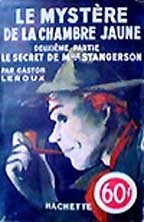
1884 - Jean
Roussel Ballmeyer and Mathilde Stangerson father Rouletabille (Leroux's MYSTERY OF THE YELLOW ROOM).
1886 - Events of LA
FILLE DE M. LECOQ. Death of Monsieur Lecoq. Jeanne Lecoq solves
the mystery of her father's death (Busnach-Chabrillat).
1905 - Death of Jean
Roussel Ballmeyer (Leroux's PERFUME OF
THE WOMAN IN BLACK).
1908 - Lucien
Lecoq, age 57, publishes his Memoirs (Anonymous Pulp Mag).
(FOR MORE ON THIS TOPIC, SEE LES HABITS NOIRS AND OUR ARTICLES ON THE CONSPIRACY, ROULETABILLE AND THE TANGLED WEB.)
[Thanks to Rick Lai, whose extraordinary research was invaluable in assembling
this article, and Bevis Benneworth and Thierry Chevrier for added information.]
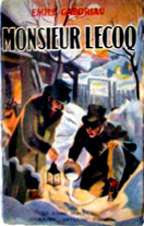 1.
Monsieur Lecoq (Fr., B&W, 1914)
1.
Monsieur Lecoq (Fr., B&W, 1914)
Dir/Wri: Maurice Tourneur.
Cast: Maurice de Féraudy, Charles
Kraus, Fernande Petit, Henry Roussel.
2. Monsieur Lecoq (US, B&W, 1915)
Dir/Wri: Maurice Tourneur.
Cast: William Morris (Lecoq), Alphonse
Ethier, Florence La Badie, Reginald Barlow, Julia Blanc, Morgan Jones.
3. The Family Stain [L'Affaire
Lerouge] (US, B&W, 1915)
Dir/Wri: Wil S. Davis.
Cast: Dixie Compton, Frank Evans, Carl
Gerard, Stephen Grattan, Edith Hallor, Louis Hendricks, Mayme Kelso, Carey Lee, Einar Linden, Walter Miller, Frederick
Perry, Helen Tiffany.
| Nina Gypsy [Le
Dossier 113] (24 July 1971) Dir: Claude-Jean Bonnardoit. Cast: Catherine Rouvel (Nina), Henri Lambert (Lecoq), François Perrot, Jacques Faber, Karine Lafabrie, Gilles Capelle, Jean-Pierre Granval, Annick Berger. |
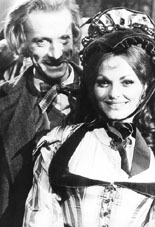 |
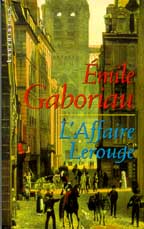 2. L'Affaire Lerouge
2. L'Affaire Lerouge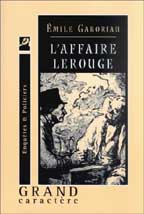 6. Histoires de Brigands
6. Histoires de Brigands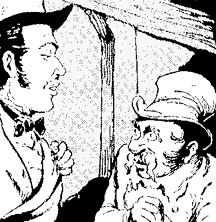 |
There were two French comic strips adaptations of Monsieur Lecoq. The first was Inpecteur Lecoq by Marc Cardus, for the Mondial Presse Syndicate in 1956-60 -- four stories representing over 800 strip.
The second was Monsieur Lecoq by Guy Marcireau for Le Parisien Libéré in 1960-67 -- several stories representing 505 strips. |